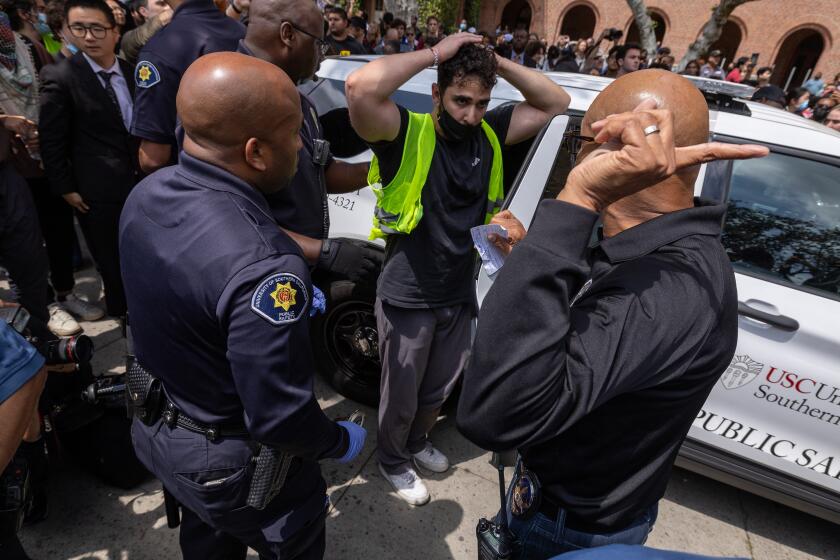Trump heads toward national emergency declaration to escape a trap he set for himself
A long tradition in the U.S. derides campaign promises as meaningless; in truth, they’re anything but that.
Presidents often find themselves boxed in by promises they make in their campaigns. Over the last few weeks, President Trump’s pledge to build a wall on the southern border has provided an especially vivid example.
The promise to build a wall began as something of a throwaway line in Trump’s campaign speeches — a concrete image he could use to connect his pledges to control immigration with his boasts of prowess in construction. Two years into his presidency, it’s become a trap.
Sign up for the Essential Politics newsletter »
WALLING HIMSELF INTO A CORNER
Just one year ago, congressional Democrats were ready to give Trump billions of dollars for the wall. The money was part of a deal in which Trump, in return, would agree to provide permanent status to the hundreds of thousands of young immigrants known as Dreamers.
“The bill failed only because of last-minute White House opposition,” Sen. Lamar Alexander (R-Tenn.) recalled in a rueful statement this week.
Immigration hard-liners led by Trump’s aide Steven Miller persuaded the president to abandon the compromise. They opposed the plan because it would have ended their hope of deporting roughly a million people currently living in the U.S., including the Dreamers and hundreds of thousands more who have lived here under so-called temporary protected status.
Since then, Trump has had no way to get Congress to approve money for the wall. With the Democrats retaking control of the House in November’s midterm election, that reality became stark.
But the promise of a wall looms over Trump’s tenure. He can’t get it through Congress, but he can’t abandon it for fear of shattering the confidence of his core supporters. With only about 40% of Americans supporting him, Trump can’t afford any erosion of his base.
So in December, Trump gambled: He would force a government shutdown by refusing to sign appropriations for a long list of government agencies unless the bills included money for a wall.
That required him to go back on another deal — this one with Senate Republicans who had approved the appropriations bills after Vice President Mike Pence reassured them Trump would sign them. Trump was willing to leave his Senate allies out on a limb rather than admit defeat.
His decision precipitated a shutdown of federal agencies that, as of midnight Friday, will move into its fourth week and become the longest in U.S. history. Some 800,000 federal workers are either working without pay or on furlough; the first missed payday for most of them came Friday.
Trump’s hope was that Democrats would back down to avoid the disruption caused by a shutdown. In a series of contentious meetings with congressional leaders this week, he threatened to keep government agencies closed for “months or even years,” as Eli Stokols and Jennifer Haberkorn reported.
Tuesday night, Trump made his first prime-time, televised speech to the country from the Oval Office, trying to make his case that a “humanitarian crisis” at the border requires the building of a wall.
As Molly O’Toole, Molly Hennessey-Fiske and Kate Morrissey reported, the reality at the border differs significantly from Trump’s description, and to the extent that a crisis exists, it’s largely a self-created one.
In any case, Trump’s speech had little impact on public opinion, and the Democrats haven’t budged. Instead a small, but steady stream of Republicans have begun to defect.
On Wednesday, Trump walked out of talks with House Speaker Nancy Pelosi (D-San Francisco) and Senate Minority Leader Chuck Schumer (D-N.Y.).
Now, with his initial gamble having yielded nothing, Trump is on the verge of upping the ante and trying to use presidential emergency powers to bypass Congress, as Stokols and Hennessey-Fiske reported.
HEADING FOR THE EMERGENCY EXIT
Declaring a national emergency to build a border wall carries multiple risks:
The plan could fail in court, where it would almost certainly face challenge.
As several conservatives in Congress have pointed out, it would also set a precedent that a future Democratic president might use to bypass Congress to pursue liberal goals.
And, since the money to build the wall has to come from somewhere, the move inevitably would enmesh the administration in fresh controversy.
As Sarah Wire reported, one possible source of wall funding the administration has looked is money currently committed to flood-control projects in California and Puerto Rico.
For Trump, an emergency declaration could be the only way he can get out of the current standoff without admitting defeat.
On Thursday, Pence killed one of the few remaining options — an effort by Sen. Lindsey Graham (R-S.C.) and a few other Republicans to revive a version of the Wall-for-Dreamers deal that Trump almost had a year ago.
“We’re kind of stuck,” Graham said as Congress prepared to leave town for the weekend.
As the shutdown begins to disrupt air travel (air traffic controllers and TSA agents are working without pay), FBI investigations, food inspections and Border Patrol operations, pressure on Congress to end the shutdown will grow.
With Trump’s Republican support already wavering, he could face the unpleasant prospect of Congress passing the appropriations measures and daring him to veto them, which would give him sole responsibility for the shutdown.
If Trump declares an emergency, he could go ahead and sign the current money bills and still tell his supporters he plans to build the wall.
ANOTHER LEGAL BATTLE
If Trump tries to use emergency powers, Democrats would file suit, effectively moving the fight from Congress to the courts. Ultimately, the border wall might never get built, but for Trump, the fight over the wall may matter more than the actual construction of it.
What of the legal case? As David Savage wrote, federal law provides that in the event of a “declaration by the president of a national emergency … that requires use of the armed forces, the secretary of Defense, without regard to any other provision of law, may undertake military construction projects … not otherwise authorized by law.”
Opponents might challenge whether Trump’s declaration of a national emergency was valid, but courts might be reluctant to second-guess the president on an issue of that sort.
Another issue might be whether the wall could be considered a “military construction project.” That’s why administration officials have been scouring other federal laws to look for additional authority to “reprogram” construction funds that Congress has authorized for other purposes.
REBUFFS IN THE MIDEAST
The administration’s top two foreign policy officials, Secretary of State Mike Pompeo and national security advisor John Bolton, both headed for the Mideast this week. As Tracy Wilkinson reported, it’s been a rough go.
In Turkey, Bolton was snubbed by that country’s president, Recep Tayyip Erdogan. And a much-ballyhooed speech by Pompeo in Cairo was largely overshadowed by the political battles back home.
The U.S. has “rediscovered our voice. We have rebuilt our relationships,” Pompeo declared, as he criticized the Obama administration’s foreign policy and sought to emphasize U.S. opposition to Iran.
But as Bolton’s experience in Turkey illustrated, foreign leaders have largely ignored that rhetoric and have focused instead on Trump’s actions, including his order to withdraw U.S. troops from Syria.
Those moves have sent a message that the U.S. is pulling back from the Mideast. Whether a pullback is a good idea or not, it’s at odds with the assertive message that Bolton and Pompeo have tried to convey. Ultimately, Trump’s actions speak louder than their words.
WHAT COLLUSION COULD LOOK LIKE
Paul Manafort’s lawyers may be good at criminal defense, but they’re not so great at redacting documents.
Manafort’s defense team filed papers in court this week in which they sought to rebut prosecutors’ allegations that their client had lied to investigators.
The court filing included several redacted sentences. But reporters quickly discovered that simply cutting and pasting the redacted passages made the black bars go away, revealing the text underneath. And what a reveal it was.
As Chris Megerian reported, the document disclosed an allegation by prosecutors that Manafort, who was Trump’s campaign chairman, had shared polling data with a Russian colleague during the 2016 campaign. The colleague, Konstantin Kilimnick, is alleged to have long-standing ties to Russian intelligence.
That’s not exactly a smoking gun, but it’s at least a gun-like object.
We don’t know what sort of polling data Manafort is alleged to have shared, how detailed it was or what period it covered. And we don’t know what Kilimnick is alleged to have done with the data, whether, for example, he might have shared it with Russian officials.
But polling data is among the most valuable assets a campaign has. And Russia was mounting a major effort in 2016 to interfere with the U.S. election — an effort aimed at helping Trump win, U.S. intelligence officials say.
Polling data from Trump’s campaign would potentially have been extremely useful to Russians involved in the election project.
Trump, naturally, denied knowing anything about it.
DEMOCRATIC FIELD BEGINS TO FORM
Last week, Sen. Elizabeth Warren (D-Mass.) formally entered the Democratic race for president, and as Noah Bierman reported, she drew large crowds on her initial campaign trip to Iowa, where the first contest of the primary season will take place in just over a year.
On Tuesday, Sen. Kamala Harris (D-Calif.) launched her new book, which builds a case for a White House bid, as Evan Halper reported. Harris is widely expected to announce her campaign later this month.
But for all the attention to fresh, new faces, two septuagenarian white guys remain at the top of the early polls. Some of that is simply name recognition for former Vice President Joe Biden and Sen. Bernie Sanders (I-Vt.), but as Halper wrote, it’s also a reminder that for many Democrats, considerations of race and age take a backseat to the overriding imperative of finding a candidate they believe can beat Trump.
Meantime, the potential field had another prominent dropout: Tom Steyer, the billionaire former hedge fund manager and funder of Democratic causes, ruled out running. As Mark Barabak reported, Steyer said he had decided, instead, to redouble his effort to prod Congress into impeaching Trump.
The potential field remains huge, but Steyer is the second high-profile Democrat to flirt with running and then decide not to try. Late last year, former Massachusetts Gov. Deval Patrick, a favorite of several people close to President Obama, announced he would not run.
LOGISTICS
That wraps up this week. Until next time, keep track of all the developments in national politics and the Trump administration at our Politics page and on Twitter @latimespolitics.
Send your comments, suggestions and news tips to politics@latimes.com.
If you like this newsletter, tell your friends to sign up.
More to Read
Get the L.A. Times Politics newsletter
Deeply reported insights into legislation, politics and policy from Sacramento, Washington and beyond. In your inbox three times per week.
You may occasionally receive promotional content from the Los Angeles Times.







